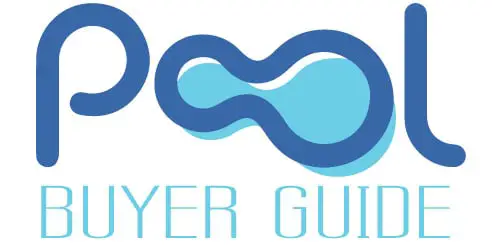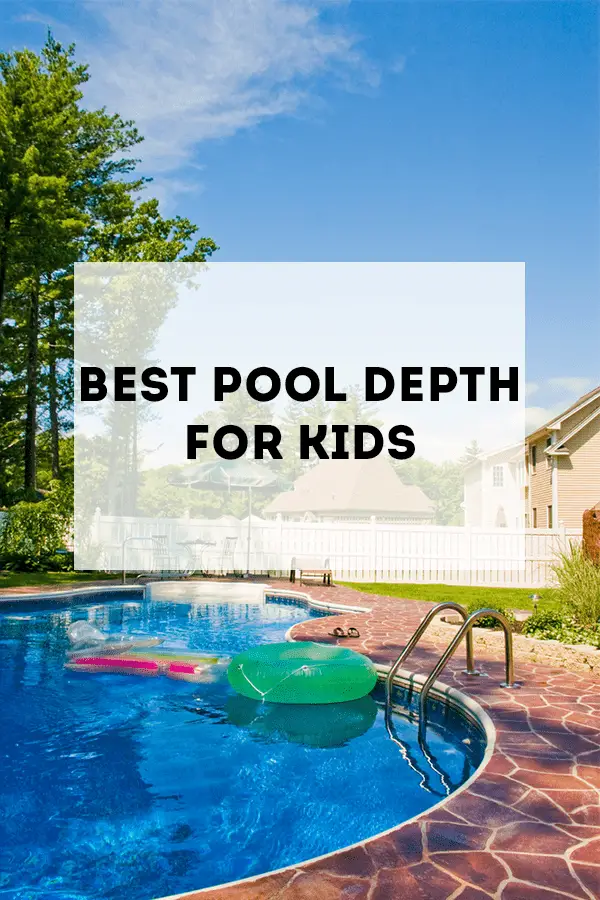
Pools are not made for the same purpose except for swimming. As such, the depth is such an important aspect when building one, most especially so since you cannot change it once the construction is complete unless you have the money to spare and rebuild it.
The best depth for children who no longer belong to the toddler category is between 3.5 and 4 feet. This depth is not recommended for diving head first. If diving is required, the minimum depth has to be nine feet, but this pool is no longer safe for kids unless the child is an expert in swimming.
Given the fact that some will frown on the idea of shallow pools, you can still remedy this by making use of several depths and designs to accommodate everyone’s taste.
Here, we shall be discussing the best pool depth that you have to consider if you are building one, most especially so if you expect children to use it quite often.
Ideal Pool Depths
Depth for Toddlers
Toddlers like to bask under the sun, and most of them are not afraid to go in the water, not knowing the possible dangers of a deep pool. If you are expecting toddlers to swim in your pool, two to three feet should be the optimal option.
Although children grow old quickly, it is still best for you to have a depth that is safe for kids. Needless to say, children must be accompanied by adults at all times. Unlike adults, toddlers carelessly move too often in the pool because they get lost in the joy of swimming. As such, they really have no clue that the depth of the pool might be transitioning to something deeper.
Due to this, a pool that has several depths that start at two feet deep must have a barrier that will prevent the kids from slipping to the deeper portion.
Even if a pool does not have waves like the sea, water movement can still toss the child to the deeper areas of the pool, and it might be too late before you even realize that it happened.
Despite having a barrier, you should still ensure that toddlers are watched all the time.
Depth for Kids
Kids who are five years old and above love to dive. The big problem with a shallow pool is that they can bump their heads or their feet on the ground, and this is going to hurt. And when a child is hurt, drowning is likely to occur, as he cannot stand despite the water being shallow.
The best depth for children who no longer belong to the toddler category is between 3.5 and 4 feet. This depth is not recommended for diving head first. If diving is required, the minimum depth has to be nine feet, but this pool is no longer safe for kids unless the child is an expert in swimming.
If the kids jump in feet first, the pool must be at least four feet deep. Deeper is better, and the child must also be accompanied by an adult at all times if he is less than four feet tall.
Always think of safety, because children tend to forget admonitions and warnings. It is always best that the kids are supervised while swimming.
Always remember:
- Two to three feet of water is best for toddlers to keep them safe and yet still foster an enjoyable swimming experience.
- For kids, 3.5 feet is the minimum requirement, and four feet is the recommended maximum depth. This ensures that children of varying height can still enjoy the pool without the need for them to stick up their heads.
- Diving is not a good idea in shallow pools as it can hurt the head and the feet.
- Always keep the children under the watch and supervision of an adult.
The Pool Design
There are many pool designs that you can choose from, most especially so if you are considering multi-depth pools.
Deep in the Middle
One common pool design is to have two shallow ends that transition to deeper waters in the middle. This is a common pool design that you will typically see in resorts. The idea is that you only let kids stay close to the edge of the pool and that anyone wandering off the sides should be called.
Typically, you want the edge of the pool to be two to three feet deep. The water gets deeper as you move inward, and it can reach a final depth of six feet or more for adults.
This design is best used in resorts where adults can sit on the pool’s edge to watch over the children, but the downside here is that you cannot install a diving board.
Also, it is a tad dangerous if you let children swim on their own. This design is not the best choice if you are building a pool in your house. It only makes sense if the pool you are building is really wide, as it can accommodate many kids to hold on to the sides of the pool.
Deep on One End
Another popular design is to have one shallow end and another deep end. This is common for home pools where children can only swim from one side to the middle, provided they have been warned not to go over to the other side. One danger here is that some kids may attempt to catch a ball that was thrown too far, and they can drown if no one is watching.
To fix this problem, what you can do is to put a barrier, as if there are two pools. This, of course, will not prevent children from crossing over if taunted. In some cases, children will also forget that the other part of the pool is deep.
L-Shape
One of the safest, but the most difficult to build is an L-shaped pool. It comes in other variations, but they are all essentially using one principle: one side is deep, and the other is shallow. The shallow part is best made with two to three feet of water, while the deep side will have at least four feet of water.
The L-shaped pool is great to divide the part for kids and the ones for adults. However, it is also costly to build, and it occupies a smaller space for the pool. Instead of creating a square pool, you are cutting a block off to create the L-shape.
Always Remember:
- Shallow ends are pools that have uniform depth on the sides. The edges must have the ideal depth for toddlers, and then the pool will slowly transition to the ideal depth for kids.
- The split-pool has one end that is deep, and the other side is shallow. This is best constructed with a barrier in the middle.
- The L-shaped pool is the best option, but it is also costly because you are building a smaller pool for the same plot of land.
Specific Safety Tips for Kids When Swimming
After choosing the right size and the right design, you still need to know that no matter how shallow the pool is, kids are still susceptible to drowning if left unsupervised.
You must also know that despite putting a barrier inside the pool to separate the shallow and deep parts, children have not yet fully matured in terms of assessing risks and dangers, and this is why some of them will try to crossover the deep part simply because they got curious.
And if no adult is around to supervise, it could end up to something tragic. Here are some tips to keep the children safe.
Fence the Pool
Make sure that no one outside the house can climb over the fence. Your neighbors might get tempted to swim, and if they do, they can drown. Make sure there is no furniture or tree that a child can climb from the outside to get into your backyard.
Make sure your children know how to swim – it is important that your kids know how to swim. It is best that you enroll them in a professional swimming class. Children four years or younger can learn how to swim really quickly. Swimming is something that everyone must learn because it is a life skill.
Cover the Drain
Several reports of children are drowning because their hair, hands, or swimming shirts got stuck in the drain. Cover the pool drain and make sure it will not snag anything.
Always have an adult supervise it – this is non-negotiable. An adult must always be around to watch over the kids. And when an adult is around, make sure that the adult is responsible enough.
The adult must not be using his smartphone playing while the kids are swimming. There have been reports of adults neglecting their children while swimming, with the kids ending up drowning while the adult had his nose stuck on the phone.
Do not allow small toys
Children will leave toys everywhere. Small toys can cause a person to trip and slip, and this can cause head injuries. Worse, the child can fall in the pool and drown.
Get an alarm
Technology today is accessible by anyone. As such, you can easily buy and install a pool alarm that will alert you should there be anyone lurking within the vicinity of the pool. Some home security cameras have a sensor, and you can use it as an alternative for a pool alarm.
Better yet, consult with the pool builder, as they are the best people to who know how to augment your pool security.
Frequently Asked Questions
Now that you know the best depth for pools for kids, and by now you must have already chosen a pool design, it is time to choose the best size for your swimming pool.
Generally speaking, the size of your pool is relative to the space available in your front or backyard. Naturally, you also want to leave out space for other activities like barbecues. You may also want to put a gazebo somewhere in there.
One definite thing is that you do not want the pool to occupy the entire space. You also have to consider functionality. If your long-term plan is to have pools for kids and still be able to exercise, then it is best to have an elongated pool so you can swim laps.
Below are some of the most common questions about building pools relative to their purpose and size.
What is the right size of the pool for family use?
Pools do not come in standard sizes like mattresses. It is completely up to you to build the size you want. However, here are some of the main things to consider before making that decision.
- Consider the main pool users if these will be kids or adults or both.
- Think about how often the pool will be used. If you want to have pool parties, a mid-sized pool is a good option, leaving a significant portion of land around it for people to walk and sunbathe.
- If you will use the pool for laps or to practice, a long pool is ideal.
- Think of the objects you want to put in your backyard. Examples of these are a gazebo, grill, furniture, and others. Once a pool is built, there is no moving it around.
How much does a pool cost?
A pool requires labor that is so much more than digging and putting tiles. It requires a lot of planning and work, especially if people will dig it manually. The cost of trucks and other machines is also enormous.
Overall, the cost revolves around the depth and the size.
On average, a pool 32 feet wide and 16 feet wide will cost about $22,000. Smaller and round ones are much more affordable, ranging between $6,000 and $10,000 if the pool is 19 feet in diameter or lower.
What other things must I consider before building one for kids?
Building pools are like building a house, considering that you need to dig and you also need concrete. It’s just that pools are pretty straightforward if put in your backyard.
Indoor pools are much more complicated to do, as it requires the appropriate architecture and more planning than an outdoor one.
Here are some major considerations when building a pool:
- Cost
Do you have the budget to build one? As mentioned earlier, pools can range between $6,000 and $22,000. Elaborate pools will cost more and can even hit as much as $30,000. You also need to think about the accessories that you need with a pool, like the water pump and other electrical necessities.
- Space
Do you have adequate space in your backyard? If so, will you use it all up for the pool? A good idea is to mark the planned pool area. After doing this, you can get a better vision of the space that it is going to occupy. Once done, you can see if you can still place benches, chairs, and other backyard accessories like plants and barbecue grills.
- Time
When do you expect to use the pool? Big pools require months to build. Smaller ones can take a matter of weeks. If the pool is primarily for baths but not for exercise and sports, opt for a smaller one that is only three to four feet tall. Despite your kids outgrowing the depth, it will still be an enjoyable activity during hot days.
Also, larger pools require a lot of maintenance. You need to remove leaves and debris, sanitize it, and put chemicals in it. Think carefully if you have the time and strength to do this. On the other hand, this will not matter if you have the financial means to pay for cleaning services and pool maintenance.
Summary
A pool for kids is a great endeavor. No child has ever said no to a pool, except babies who do not like water. But most of them will outgrow this fear as they get older.
Remember that there is an appropriate depth for kids. These depths are generally acceptable around the world, as these are the average height of kids before they hit their teenage years.
To summarize everything, here are some takeaway points that you have to keep in mind.
- The ideal pool depth for toddlers is two or three feet.
- For kids, the ideal depth is 3.5 feet to four feet.
- There are three main pool designs that you can choose from—both ends shallow, shallow on one end and deep at the other end, and L-shaped pool with each side having a different depth.
- Consider the cost that the pool will entail.
- Think about the activities you want to do around and in the pool before deciding what type to build.
- Make your pool safe by fencing and putting alarms.
- Always have a responsible adult supervise swimming activities.
So, there you have the best depths for kids’ swimming pools. By the time you decide to build one, we are hoping that you take these pointers and incorporate them into your decision. Make your children happy, but also make them safe all the time.


